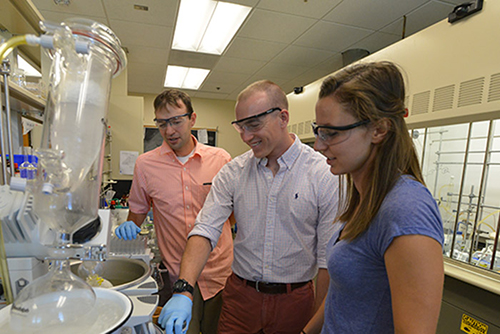2015-2016 | Football Metrics: Playing to Learn
Energy from Carbon Dioxide?
 |
|
Maj. Dan Harrison ’05 supervises Daniel Chisner ’19 and Samantha Shepherd ’18 in the chemistry lab. – VMI Photo by Kelly Nye. |
LEXINGTON, Va., June 30, 2016 – Sometimes chemistry projects teach cadets life lessons as well as new science. This summer, Maj. Dan Harrison ’05 and two cadets, Samantha Shepherd ’18 and Daniel Chisner ’19, have learned lessons in delayed gratification.
The long-term goal of their project is to make solar fuels out of carbon dioxide (CO2), a process similar to photosynthesis, in which plants use light to convert carbon dioxide, which we exhale, into oxygen, which we inhale. But in the process Harrison and his cadets are developing, fuel is the byproduct instead of oxygen. It essentially creates energy out of thin air – part of it, anyway – and thanks to the greenhouse effect, there is too much of that part, carbon dioxide. Using some of it up could be a step toward decreasing the effects of global warming.
“The goal is to create a carbon-neutral society,” said Chisner, who worked this summer under a Summer Undergraduate Research Institute grant. “So the amount of CO2 that you’re emitting is being pumped back in and … used after you burn off the fuel that you created.”
But the cadets are still in the building blocks stage.
Shepherd and Chisner will finish at VMI long before any solar fuels are created, and future chemistry majors will work with Harrison to build upon the information they discover. Harrison has no shortage of subprojects to occupy cadets along the way. And as they work on their subproject, Shepherd and Chisner are learning the skills necessary to analyze the theory and to become scientists.
“So we teach them the skills and that just becomes second nature, and then they actually begin to think deeply about the projects,” said Harrison. “And then eventually they begin to develop the projects. They become our colleagues rather than our students; they teach us about these things.”
Shepherd and Chisner, though in different stages of the process, started by making the materials that will produce electro-polymers. Electro-polymers are essentially chains of molecules created using electricity in a process called polymerization.
Shepherd used chromatography to separate impurities in the material. She also looked for a way to attach a catalyst within the electro-polymer, which is necessary to convert the carbon dioxide into fuel, by using transition metals. Chisner created compounds similar to Shepherd’s but with additional carbon atoms, which can completely change electro-polymers’ properties.
Then both of them studied the stability and catalytic activity of the new compounds.
“And because we have this broad range of things that they’ve made, we’ll get a really good understanding of how they behave,” added Harrison.
Shepherd also used compounds that she created during her SURI project last year, some of them previously unknown. This year her work was supported by the chemistry department’s Summer Undergraduate Research Program under the SURI umbrella. She and Chisner will continue work with Harrison on the project in the fall.
When Chisner graduates, he will commission into the Marine Corps and later hopes to continue to do work in chemistry. Shepherd hopes to work for the Department of Defense one day, and she plans to earn her doctorate so she can work in synthesizing explosives.
Both are pleased to be working on a project that could have a real effect on the environment.
“You’re always really excited to get on with your next project because you know eventually it could probably help save the world,” said Chisner.
And they are not discouraged by how long the project will take.
“If someone comes along and gets it done based on our help, … then that’s amazing to me,” said Shepherd.
– Kelly Nye
-VMI-
.svg)
.png)